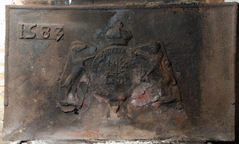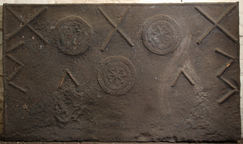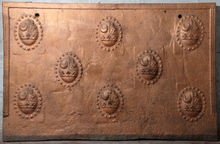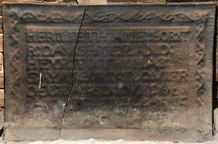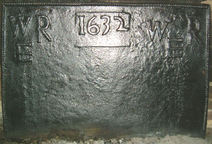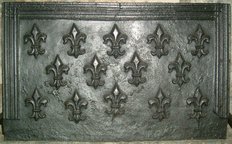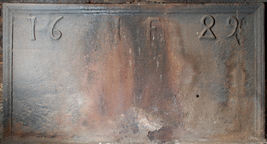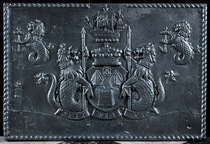-
1041
Description: Rectangular; twisted rope edging (top and upper three-quarters of sides); central Tudor shield, garter, crown and supporters (greyhound and lion), formed from separate stamps; date on a single stamp in top left corner.
Notes: This is an early example of a fireback being used as a pattern, with the addition of a subsequent date. The same stamps forming the arms can also be seen on other firebacks. The extension of the lower part of the ‘3’ on the date stamp suggests that the numbers may have been fixed to the backing block, rather than the date being carved as a whole. Another variant of this fireback has the rope edging extending further down the sides.
Inscription: 1583 / HONE SOVT qVEY MAL Y PENSE
Arms: Tudor royal (prob. Henry VIII)
- Decoration tags:
- rectangular (shape)
- rope (edging)
- carved stamps
- date stamp
- armorial
- royal
- text
Manufactured: in 1583 in the Weald area of England.
Current location: in private hands, West Hoathly, West Sussex, England.
- Attached to series:
- Pounsley series
- Tudor royal armorial firebacks
- Tudor redated series
-
1042
Description: Rectangular; twisted rope edging (top and sides); top centre, twisted rope saltire between two food moulds used as stamps, comprising two concentric discs with a hatched design and enclosing four hearts arranged in a cross; below the saltire another food mould stamp; in the top corners, a twisted rope saltire with a double V design below each, the open ends facing inwards; below each of the upper pair of food mould stamps, an inverted twisted rope V.
Notes: The food mould stamps can be seen on another fireback dated to 1562; the rope Vs and saltires have an apotropaic, or evil averting, purpose.
- Decoration tags:
- rectangular (shape)
- rope (edging)
- simple stamps
- carved stamps
- apotropaic
- objects
Manufactured: in the mid-16th century in the Weald area of England.
Current location: Manor House, North Lane, West Hoathly, West Sussex, England.
Citation: Hughes, G. B., May 1940, 'Old English Firebacks', Apollo, 31, 185, pp. 117-120.
- Attached to series:
- Food mould stamp firebacks
- Heart cross stamp series
-
1043
Description: Rectangular; triple-fillet moulded edging formed of lengths of carved wood (top and upper seven-eights of sides only); stamp formed of an elliptical shield enclosed within an elliptical border of 23 beads, all mounted on a rectangular block, repeated eight times symmetrically 3-2-3.
Notes: This is a rare example of elliptical arms on a fireback; in each instance the stamp has been over-pressed so that the block on which it was carved has appeared in relief.
Arms: not known
- Decoration tags:
- rectangular (shape)
- triple-fillet moulding (edging)
- simple stamps
- carved stamps
- heraldic
- armorial
Manufactured: in the 17th century in England.
Current location: in private hands, West Hoathly, West Sussex, England.
- Attached to series:
- Personal armorial firebacks
-
1052
Description: Rectangular; rope edging on top and sides; central inscription panel; repeated trailing vine decoration from impressed wooden strips — one horizontal line at top, one vertical strip at each side.
Notes: The inscription panel is identical to that on the memorial plate to Anne Forster in Crowhurst church, Surrey; at least ten other firebacks are known with the same inscription panel. Formerly at Stonelands, West Hoathly.
Inscription: HER : LIETH : ANE : FORST/ R : DAVGHTER : AND : / HEYR : TO : THOMAS : / GAYNSFORD : ESQVIER / DECEASED : XVIII : OF: / IANVARI : 1591 : LEAVYNG / BEHIND : HER II : SONES : / AND : V : DAVGHTERS
- Decoration tags:
- rectangular (shape)
- rope (edging)
- simple stamps
- carved pattern panels
- text
- plants
Manufactured: in the late-16th century possibly at Pounsley Furnace, Framfield in the Weald area of England.
Current location: The Old Parsonage, North Lane, West Hoathly, West Sussex, England.
-
780
Description: Rectangular; twisted rope edging (top and sides); top corners, initials in separate stamps arranged in triad with ‘WR’ above ‘E’; top centre, date on single block overstamped.
Notes: It is somewhat puzzling why a furnace should have a stock of letters but not of numerals. The use of a block for the date suggests that other firebacks may bear the same stamp.
Inscription: WER [triad] 1632 WER [triad]
- Decoration tags:
- rectangular (shape)
- rope (edging)
- individual letters
- date stamp
- text
Manufactured: in 1632 in the Weald area of England.
Current location: Priest House, West Hoathly, West Sussex, England.
Museum number: 1944.24.233 (part of the Sussex Archaeological Society museum group)
- Attached to series:
- Date & initials firebacks
-
1223
Description: Rectangular; no edging; top centre, inscription, FF, and date, 1732, separated by a small saltire.
Notes: The possibility exists that the initials are those of Francis Fairburn, whose descendants are known to have occupied the house where it lies.
Inscription: FFx1732
- Decoration tags:
- rectangular (shape)
- none (edging)
- individual letters
- individual numbers
- text
Manufactured: in 1732 possibly in the Weald area of England.
Current location: in private hands, West Peckham, Kent, England.
- Attached to series:
- Date & initials firebacks
-
1071
Description: Rectangular; cavetto-moulded edging; horizontal line of twisted rope parallel with the top; two vertical lines of twisted rope parallel to the sides; fillet arc inside the corner of the horizontal and vertical lines; each arc encloses 28 (left) or 29 (right) 'daisy heads', with a line of the same stamp around the inside of the lines; in the top corners, the split date; in the top compartment, initials, TH, between 22 hollow saltires, each with a central bead, in a horizontal line, 11 on each side; in each side compartment, at least seven hollow saltires arranged vertically.
Notes: The fireback is partially sunk into the floor of the hearth, so its height is not known.
Inscription: 16 TH 99
- Decoration tags:
- rectangular (shape)
- cavetto (edging)
- carved stamps
- individual numbers
Manufactured: in 1699 in the Forest of Dean area of England.
Current location: in private hands, Westbury on Severn, Gloucestershire, England.
- Attached to series:
- Hollow saltire series
- Newent area group
-
786
Description: Rectangular; edging on top and sides formed from four impressions of a length of wooden moulding approx. 600mm long, rebated at the right end, and overlapped starting on the right. Within are 14 impressions of a fleur de lys, arranged in three horizontal rows (5-4-5), carefully spaced with the middle stamp on the bottom row slightly out of line with the others. The edging does not reach the bottom of the plate, which is left plain.
Notes: Here is the distinctive use of wooden moulding salvaged from another use, possibly furniture, the moulded end of the sections suggesting that it might have come from a corner; the style of fleur de lys is one of three encountered on firebacks in this series.
- Decoration tags:
- rectangular (shape)
- complex, furniture-derived (edging)
- simple stamps
- carved stamps
- heraldic
Manufactured: in the mid- to late-16th century possibly at Pounsley Furnace, Framfield in the Weald area of England.
Current location: Quebec House, Westerham, Kent, England.
Museum number: 528987.1 (part of the National Trust museum group)
- Attached to series:
- Pounsley series
-
879
Description: Rectangular; ogee-moulded edging (top and sides); at top, initials in middle, date split between top corners; large letters; straight base to number '8'.
Notes: The '8' is more typically found with the straight edge at the top.
Inscription: 16 IF 89
- Decoration tags:
- rectangular (shape)
- cyma reversa/ogee (edging)
- carved stamps
- individual letters
- individual numbers
- text
Manufactured: in 1689 in the Weald area of England.
Current location: in private hands, Westfield, East Sussex, England.
- Attached to series:
- Date & initials firebacks
-
1093
Description: Rectangular; simulated twisted rope edging with a gap, top centre; centre, shield, baron's coronet, supporters and crest; in each top corner, heraldic badge - a Sea Lion holding an anchor.
Notes: The arms are of Sir Hudson Ewbanke Kearley, Bt., 1st Baron Devonport (1856-1934); created 1910, he was elevated to Viscount in 1917, thus the fireback would have been cast between 1910 and 1917. Blazon: Azure in chief two Mitres Argent garnished Or and in base a Square Tower of the second, a baronet's badge in chief; Supporters: On either side a Sea Lion Argent crined finned and tufted Or each gorged with a Collar Gules charged with three Roses of the second and each supporting a Spear erect proper; Crest: An Ancient Ship Or the Mainsail Azure charged with a Sea Lion of the first; Motto: Fit Via Vi (The way is made through strength). A version with the same arms and badges has an arched rectangular shape and plain edging.
Inscription: FIT VIA VI
Arms: Hudson Ewbanke Kearley, 1st Baron Devonport (later 1st Viscount)
- Decoration tags:
- rectangular (shape)
- simulated rope (edging)
- heraldic
- armorial
- text
Manufactured: in the early-20th century in England.
Current location:, not known.
- Attached to series:
- Personal armorial firebacks
- Devonport arms series
